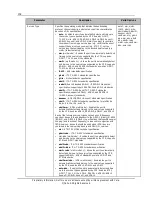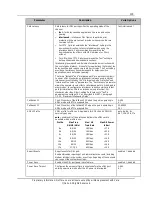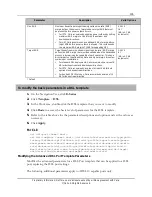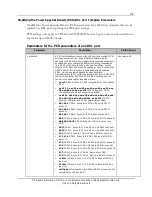
132
Proprietary Information: Not for use or disclosure except by written agreement with Calix.
© Calix. All Rights Reserved.
Parameter
Description
Valid Options
Service Type
Specifies the operating mode that dictates the handshaking
protocol, channel capacity, and other physical line characteristics
based on xDSL specifications.
auto
– Enables the port to automatically detect and train up to
the service type supported by the CPE. Enables G.DMT,
T1.413, G.Lite, ADSL2, READSL2, ADSL2+,ADSL2 Annex M,
ADSL2+ Annex M, and VDSL2. Note: If you want to constrain
the modem from using a service type (e.g. vdsl2) that does not
support the service type you want (e.g. ATM-TC), set the
service type that only applies to the desired service type (e.g.
mm2+) rather that using auto.
mm
(multi-mode) – Enables the port to automatically detect and
train up to the service type supported by the CPE; supports
G.DMT, T1-413, and G.Lite standards
mm2+
(multi-mode 2+) – Allows the port to automatically detect
and train up to the service type supported by the CPE; supports
ADSL2+, ADSL2, and READSL2 standards as well as G.DMT,
T1-413, and G.Lite standards
t1.413
– ANSI standards specification
g.dmt
– ITU-T G.992.1 standards specification
g.lite
– G.Lite standards specification
adsl2
– ITU-T G.992.3 standards specification
readsl2
(Reach Extended ADSL2) – READSL2 standards
specification; supports both READSL2 and ADSL2 standards
adsl2+
– ITU-T G.992.5 and ITU-T G.992.3 standards
specification; supports ADSL2+, ADSL2, and READSL2
(G.992.3, annex-L) standards
annexm
– ADSL2/ADSL2+ Annex M standards specification
vdsl2
– ITU-T G.993.2 standards specification for profiles 8a,
8b, 8c, 8d, 12a, 12b, and 17a
vdsl2mm
– (VDSL multi-mode) – Enables the port to
automatically detect and train up to the service type supported
by the CPE; enables ADSL2, READSL2, ADSL2+, and VDSL2
Each of the following service types use the Annex B frequency
spectrum. Annex B is an addendum to the G.992.1 (G.dmt), G.992.3
(ADSL2), and G.992.5 (ADSL2+) specifications that specifies power
shaping (as a function of frequency) to be used in conjunction with
ISDN services. Annex B should be used when ISDN lines are
contained in the same wiring bundle as ADSL/2/2+ services.
etsi
– ETSI TS 101 388 technical specification
gdmt-isdn
– ITU-T G.992.1 standards specification
mm-isdn (multi-mode) – Enables the port to automatically detect
and train up to the service type supported by the CPE; supports
ETSI and G.DMT standards
adsl2-isdn
– ITU-T G.992.3 standards specification
adsl2+-isdn
– ITU-T G.992.5 standards specification
mm2+-isdn
(multi-mode 2+) – Allows the port to automatically
detect and train up to the service type supported by the CPE;
supports ADSL2+, ADSL2 standards as well as G.DMT and
ETSI standards
vdsl2mm-isdn
– (VDSL multi-mode) – Enables the port to
automatically detect and train up to the service type supported
by the CPE; enables ADSL2, ADSL2+ and VDSL2
auto-isdn
– Enables the port to automatically detect and train
up to the service type supported by the CPE. Enables ETSI,
G.DMT, T1.413, G.Lite, ADSL2, READSL2, ADSL2+,ADSL2
Annex M, ADSL2+ Annex M, and VDSL2.
auto ‡, mm, mm2+
t1.413, g.dmt, g.lite,
adsl2 readsl2, adsl2+,
annexm, vdsl2,
vdsl2mm, etsi, gdmt-
isdn, mm-isdn, adsl2-
isdn, adsl2+-isdn,
mm2+-isdn, vdsl2mm-
isdn, auto-isdn
















































